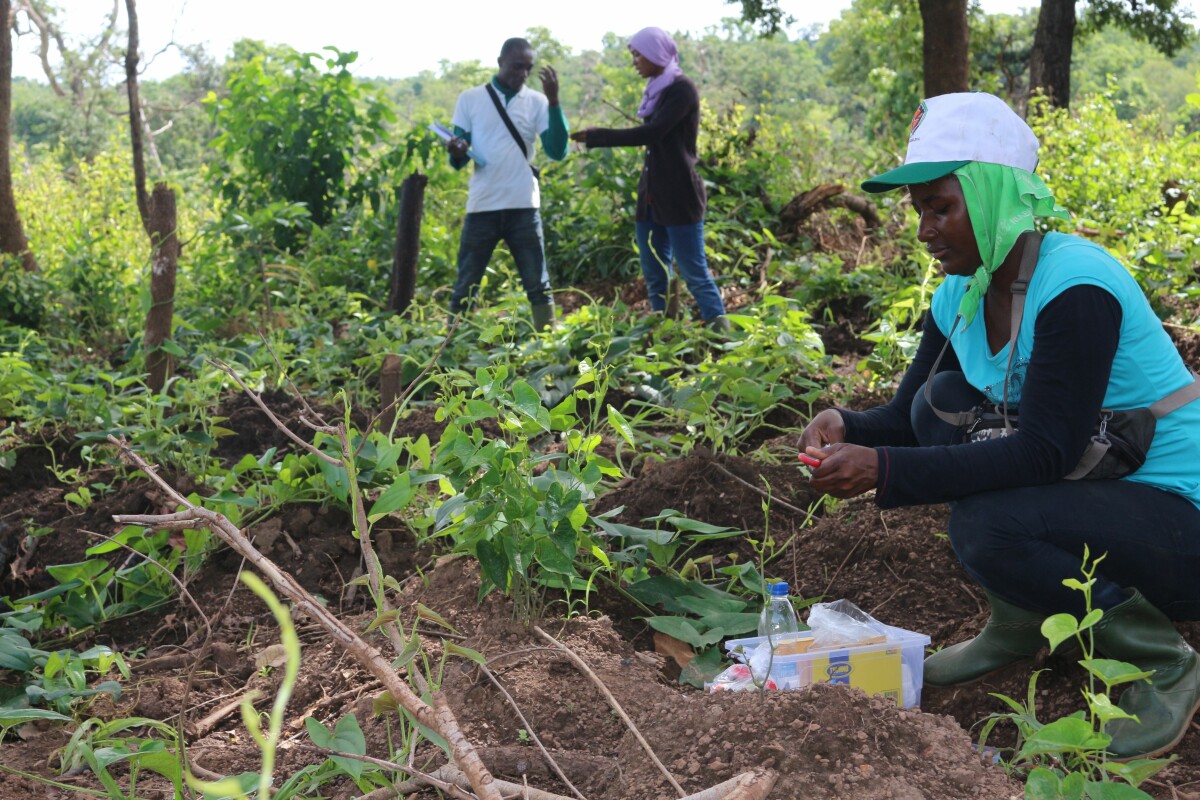Discovering the viruses of yam in Côte d’Ivoire

Certain species of Dioscorea, better known as yam, are important sources of food and pharmaceuticals. In West Africa this root crop is an essential dietary source of calories for around 60 million people and a key ingredient in the region’s cuisine. A major constraint on yam production in West Africa is infection by plant viruses, most of which are transmitted by insects with probing-sucking mouthparts such as aphids and whiteflies.

Whiteflies (A) and aphid (B) feeding on plant leaves.
Since the yam crop is mostly produced by smallholders, including many women farmers, work to improve the diagnosis and control of yam-infecting viruses has the potential to contribute to the livelihoods of yam growers and their families, as well as to the maintenance of food security in the region. Unfortunately, yam is a neglected crop with respect to scientific research on its interactions with viruses.
The premier centre for research on viral diseases of root crops such as yam, as well as cassava and sweet potato, in the region is WAVE (the Central and West African Centre for Viral Epidemiology). With its main hub located in Abidjan, Côte d’Ivoire, WAVE is a strong network of 13 universities and national agricultural research institutions, in 10 West and Central African countries, that permits region-wide responses to plant pathogens. Dr Josiah Musembi Mutuku, the Director of Research at WAVE, collaborated with John Carr of the Plant Sciences Department at Cambridge University on a proposal to the ALBORADA Fund of Cambridge-Africa to investigate the virome, that is, the community of viruses, associated with yam plants and the aphids and whiteflies that infest them.

Dr Josiah Musembi Mutuku (left) and John Carr (right).
In the major growing areas of Côte d’Ivoire under Josiah’s direction, samples of yam tissue were gathered, and insects trapped, placed into preservative before being sent to Cambridge for further analysis.

A map of Côte d’Ivoire showing the locations of yam sampling sites.

WAVE scientists collecting yam samples in Côte d’Ivoire.
Yam and insect samples were used to extract RNA, which was subjected to high-throughput sequencing using the Oxford Nanopore system, which reads individual strands of nucleic acid (RNA or DNA) as they pass through tiny holes in a membrane.
This element of the work was led by Dr Alex Murphy, together with Ms Mariam Combala, an early-career scientist from WAVE, who was seconded to Cambridge to help with the analysis). Mariam received training in sequencing and analysis of the sequencing data (‘bioinformatics’) to identify viral sequences hidden within the vast number of plant and insect sequences detected by the Nanopore device. Using ALBORADA funding, Mariam was able to take back to WAVE a ‘MinIon’ Nanopore device and a computer and software needed to analyse its output data, which enabled her to establish at the Abidjan WAVE Hub, an independent capability for this technology.

The Oxford Nanopore MinIon kit (A) and (B) in use by Alex Murphy (left) and Mariam Combala (right). The Nanopore cell is circled in both images.
Yam is affected by DNA and RNA viruses. The most important DNA viruses are ‘begomoviruses’, which have genomes of single-stranded DNA and are transmitted mainly by whiteflies. The most common begomoviruses in the North and North-East Districts of Côte d’Ivoire were sweet potato leaf curl virus and sweet potato golden vein-associated virus. In the country’s Central Districts, we detected several begomoviruses that are usually associated with diseases of tomato such as tomato leaf curl Nigeria virus, as well as tomato yellow leaf curl Saudi virus and tomato leaf curl Comoros virus. These results were unexpected and suggest that there is a flow of viruses between yam and solanaceous crop plants such as tomato. As expected from previous work using conventional detection techniques, the most common aphid-transmitted RNA viruses are yam mosaic virus.
Sequencing of insect and plant samples detected viruses that could have future potential as biocontrol agents against insect vectors of plant disease. Hence, the project also provided data to support an application for a collaborative grant on insect-pathogenic viruses with WAVE funded by the Royal Society and the Global Challenges Research Fund. Thus, importantly, the ALBORADA funding allowed John and Josiah, together with Professor Justin Pita (the WAVE director) and his colleague Dr Cyrielle Ndougonna to further extend the Cambridge-WAVE partnership.
By Professor John Carr, Plant Virology & Molecular Plant Pathology Group, Department of Plant Sciences, University of Cambridge.

